There are 32 turtles in Florida of which 26 species are freshwater. These are spread across a variety of habitats, presenting several options if you’re looking to own one as a pet. The turtles native to Florida range from Diamondback terrapins, Cooters, and Sliders to a range of Mud and Musk turtles.
Florida is a haven for various turtle species including loggerhead turtles and leatherback turtles, offers unique opportunities for turtle enthusiasts. The state’s diverse habitats, from South Florida’s beaches to the Canaveral National Seashore, are crucial for the survival of these species. This article will guide you through the different turtles you can find in Florida, including their habitats and the efforts of environmental groups and sea turtle conservancy to protect them.
To help you choose one of these turtles as your next pet, we’ll cover the general information and care requirements of each species, both native and non-native. You can also use this information as a herping guide should you venture out looking for Florida’s native turtles.
Florida is also home to one tortoise species as well as five species of Sea turtles that can be spotted off the coast of Florida. While the Gopher tortoise and Sea turtles can’t be kept as pets, we’ll give you an overview of each species in case you observe them in the wild.
When choosing a pet turtle, make sure to only adopt or buy a captive-bred specimen. Taking native turtles from the wild or releasing non-native species can negatively impact the local environment and other native animal populations. Always check your local laws related to buying, owning, and selling any endangered species.
So without further ado, here are the 32 types of turtles found in Florida.
Table of Contents
Turtles in Florida
lorida’s rich ecosystems support a variety of turtles. For instance, in Brevard County and Melbourne Beach, you can participate in a turtle walk to witness nesting sea turtles. The Florida snapping turtle, coastal plain cooters, and the Escambia map turtle are some of the fascinating species you might encounter.
This guide not only helps in identifying the turtles but also highlights the best places in Florida to spot these fascinating creatures.
Box turtles
1. Eastern Box Turtle
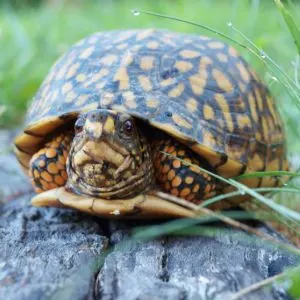
- Experience Level: Beginner
- Family: Emydidae
- Scientific Name: Terrapene carolina carolina
- Other Names: Land turtle
- Adult Size: 5 to 6 inches
- Lifespan: 40 to 100 years
- Average Price Range: $250 to $380
Eastern Box turtles are active during the daytime, spending their days roaming around foraging for food. These beautiful turtles have distinctive dark shells with orange patterns and are found mainly in Florida’s southern regions, preferring grasslands, marshes, and woodland areas.
When keeping Eastern Box turtles, a juvenile requires a 20-gallon tank at the minimum, while an adult specimen needs an enclosure measuring about 4 ft by 18 inches high. The best way to house these turtles is in an outdoor enclosure similar to their natural habitats.
The ambient temperature in their enclosure should be between 75°F and 80°F, with a basking spot of around 85°F to 88°F. Humidity should be kept at around 70%.
Eastern Box turtles will need both heat and UVB light if being kept indoors. Any lights should be kept on a 12-hour day/night cycle. These turtles don’t really like being handled, so keep this to a minimum.
These turtles prefer mulch and pelleted types of substrates that mimic their habitat while also providing enough depth for the turtle to can bury itself.
Eastern Box turtles are omnivores and should eat a mixed diet of dark greens, vegetables, and protein such as crickets, earthworms, mealworms, and mollusks.
2. Florida Box Turtle

- Experience Level: NA
- Family: Emydidae
- Scientific Name: Terrapene carolina bauri
- Other Names: N/A
- Adult Size: 4.5 to 6.5 inches
- Lifespan: 25 to 30 years
- Average Price Range: $270 to $400
Florida Box Turtles have dark, almost black shells with stunning orange markings along with yellow stripes on their heads. Their natural habitat consists of marshes, swamps, or forests in the Florida Keys region. They love to lie in the water, but don’t actually swim that often.
This species does well in outdoor enclosures or Rubber Maid tubs decorated with artificial or live plants to give them cover and shade. A log or slab or rock makes for an ideal basking spot. Florida Box turtles like to have a water dish they can lay down in, but it shouldn’t be deep enough for swimming.
Like many reptiles, Florida Box turtles need to be exposed to UV light, which you can provide using a UVB bulb. Temperatures should be kept somewhere between 70°F and 90°F with a basking spot of 85°F to 95°F. Humidity should be maintained at around 70% to 90%.
As omnivores, Florida Box turtles should eat a varied diet consisting of crickets, earthworms, mealworms and mollusks for protein alongside dark, leafy greens and other vegetables.
These small turtles are actually tolerant of handling, making them a good pet species. However, it is against the law to keep more than two Florida Box Turtles without a permit, so keep this in mind.
3. Gulf Coast Box Turtle
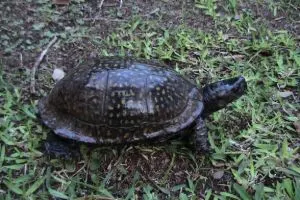
- Experience Level: Intermediate
- Family: Emydidae
- Scientific Name: Terrapene carolina major
- Other Names: N/A
- Adult Size: 6 to 8.5 inches
- Lifespan: 30 to 40 years
- Average Price Range: $230 to $450
Gulf Coast Box turtles are the largest of the Common Box turtle subspecies and are found in brackish waters, estuaries, and swamps around the Gulf of Mexico. These turtles have dark brown or black shells with fluted edges and yellow dot or stripe markings.
Gulf Coast Box turtles should ideally be kept in an outdoor enclosure of at least 4 ft by 8 ft with access to a shallow water area that they can soak in. Logs, plants, and rocks should be provided for some cover, as these turtles can be quite nervous and not suited for handling.
This species prefers warm, humid areas, so the ambient temperature should be kept around 80 to 85°F with a basking spot of 90°F. Access to UVB light should also be provided, either in the form of direct sunlight outside or a UV lamp on a 12-hour day/night cycle. Humidity should be maintained between 60% and 90% through misting.
Like many Box turtles, Gulf Coast Box turtles have an omnivorous diet and should be fed crickets, earthworms, mealworms, and mollusks along with leafy vegetables such as collard greens and dandelions. Feed your turtle every two to three days.
4. Three-toed Box Turtle
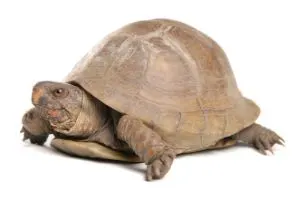
- Experience Level: Beginner
- Family: Emydidae
- Scientific Name: Terrapene Carolina Triunguis
- Other Names: Box turtle
- Adult Size: Between 5 and 7 inches
- Lifespan: Between 50 and 100 years
- Average Price Range: Between $250 and $450
The smallest subspecies of the Common Box turtle, Three-toed Box turtles are found in Northwestern Florida around the Florida Panhandle area. The main habitats for these terrestrial turtles are woodlands and other grassland areas such as meadows.
Three-toed Box turtles have high domed carapaces which are usually light brown or tan in color. As their name implies, they have three claws on their hind-legs rather than four. These turtles are not suited for handling, which should only be done when necessary.
Like most Box turtles, this species should ideally be kept outdoors in a custom enclosure of about 4 ft by 6 ft. The walls of the enclosure should have supports buried about 10 inches under the surface to prevent your turtle from burrowing out.
Ambient temperature needs to be between 75°F and 80°F with a basking spot of 85°F to 88°F. These turtles like humid areas of around 70% to 80%. If your turtle lives indoors, a UVB lamp should be used. You should also provide a shallow water dish that your specimen can soak in.
Three-toed Box turtle are omnivores and should be fed dark leafy greens such as collard greens and dandelions as well as protein foods like insects, mollusks, and worms.
Chicken Turtles
5. Chicken Turtle

- Experience Level: Intermediate
- Family: Emydidae
- Scientific Name: Deirochelys reticularia reticularia
- Other Names: American Snake-necked turtle
- Adult Size: Between 4 and 10 inches
- Lifespan: Between 15 and 30 years
- Average Price Range: Between $130 and $200
- Where To Buy: theturtlesource.com
Chicken turtles are medium-sized semi-aquatic turtles found in wetland areas with slow-moving waters. Two subspecies can be found in Florida; Eastern Chicken turtles (Deirochelys reticularia reticularia) and Florida Chicken turtles (Deirochelys reticularia chrysea).
Eastern Chicken turtles have green shells and yellow markings similar to the pattern of a net, but on Florida Chicken turtles these patterns are usually wide orange and yellow bands. Chicken turtles have long, striped necks.
These turtles require a more aquatic setup with a small land area for basking. Males will need a 75-gallon tank while females require a 125-gallon tank. They don’t like too much water movement but will still need adequate filtration.
The ambient temperature for these turtles should be between 70°F and 80°F, whilst the water temperature needs to remain in the mid-70s. A basking spot of between 85°F and 90°F is ideal. Decorate the tank with artificial or live plants along with rocks to generate some cover.
Chicken turtles mainly eat fish, so feed them crustaceans such as shrimp along with small fish and worms. You should also give your Chicken turtle some dark leafy greens as well to keep their diet varied. Like most turtles, Chicken turtles need UVB light to bask under, so provide a UV lamp that is kept on a 12-hour day/night cycle.
Cooter Turtles
6. Eastern River Cooter
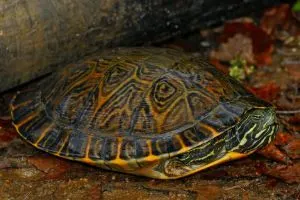
- Experience Level: Beginner to Intermediate
- Family: Emydidae
- Scientific Name: Pseudemys concinna
- Other Names: N/A
- Adult Size: Between 8 and 16 inches
- Lifespan: Between 20 and 40 years
- Average Price Range: $20 to $50 (Eastern River Cooters), Protected Species (Suwanee Cooters)
- Recommended Books: Aquatic Turtles: Sliders, Cooters, Painted, and Map Turtles (R.D. Bartlett)
River Cooters are large freshwater aquatic turtles found in fast-moving rivers and streams across the Eastern USA. There are two subspecies found in Florida; the Eastern River Cooter (Pseudemys concinna concinna) and the Suwanee Cooter (Pseudemys concinna suwanniensis), which is endemic to Florida and found mainly in the Suwanee River.
Eastern River Cooters have dark green shells with C-shaped markings on their lower scutes. Suwanee Cooters have darker, almost black shells with darker C-shaped patterns.
It is illegal to possess or sell Suwanee Cooters as they are a protected species, with pollution and increased predation in the wild being the most common dangers.
Eastern River Cooters can still be kept as pets, and will require a large outdoor pond or a 300-gallon stock tank. These enclosures need powerful filtration to keep waste down, with a water depth of between 1 and 2 feet for adult specimens.
The water temperature should be kept at around 75°F, and they will also need a basking spot out of the water that is maintained at 85°F. If you Eastern River Cooter is being housed indoors, you’ll also need to provide UVB light on a 12-hour day/night cycle.
River Cooters are mostly herbivores, so their diet should consist of dark leafy greens such as collard greens, dandelions, and romaine lettuce as well as aquatic plants in their enclosures. Hatchlings and juveniles will need some protein in their diets as well.
7. Florida Red-bellied Cooter
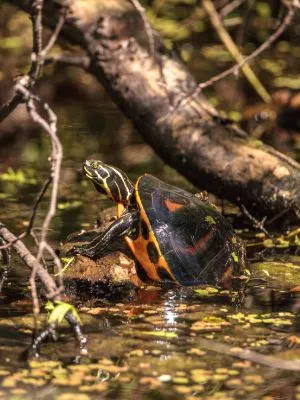
- Experience Level: Beginner
- Family: Emydidae
- Scientific Name: Pseudemys nelsoni
- Adult Size: 12 to 13 inches
- Lifespan: 40 to 55 years
- Average Price Range: $25 to $65
- Recommended Books: Aquatic Turtles: Sliders, Cooters, Painted, and Map Turtles (R.D. Bartlett)
Florida Red-bellied Cooters can be found in the Okefenokee Swamp region that spans from southern Georgia into Florida. These large aquatic turtles have distinctive red plastrons which give them their name.
If you are planning to keep a Florida Red-bellied Cooter as a pet, a 100-gallon tank is the minimum size that you’ll need. A Rubber maid container can also be used, but an outdoor pond is even better. These turtles love to swim and require deep water, so a 5 ft by 5 ft pond is ideal.
Water temperature should be maintained at around 70°F to 75°F. If the water temperature is too low, use a water heater. You should use a medium-sized gravel substrate and provide a basking spot of about 85°F to 90°F.
These turtles like to bask a lot, so a UVB light is also a must if you’re keeping your Florida Red-bellied Cooter inside. An outdoor pond should get some direct sunlight.
Florida Red-bellied Cooters can eat prepared turtle diets such as Mazuri and ReptoMin, but they are natural herbivores. Aquatic plants, dark leafy greens, and some vegetables should be the staples of their diet.
8. Peninsula Cooter

- Experience Level: Beginner
- Family: Emydidae
- Scientific Name: Pseudemys peninsularis
- Other Names: N/A
- Adult Size: 9 to 13 inches
- Lifespan: 30 years
- Average Price Range: $25 to $50
- Where To Buy: theturtlesource.com
- Recommended Books: Aquatic Turtles: Sliders, Cooters, Painted, and Map Turtles (R.D. Bartlett)
Peninsula Cooters are durable freshwater turtles and are a medium-sized aquatic species. They are endemic to the Florida Peninsula and have dark colored shells with orange or yellow patterns. They have lighter plastrons than Florida Red-bellied Cooters.
When it comes to housing a Peninsula Cooter, a 75 to 100-gallon tank is ideal. These turtles also do well in outdoor ponds, which is closer to their natural habitats. Any enclosure should have adequate filtration with a fairly fast current.
The ideal water temperature for Peninsula Cooters is between 75°F and 80°F, with a basking spot of about 85°F to 90°F set out of the water. UVB light should also be provided and kept on a 12-hour day/night cycle. Use a water heater if you cannot achieve the ideal temperature.
Peninsula Cooters prefer some cover in the form of artificial or live plants and rocks. Adult specimens will prefer a herbivorous diet of dark leafy greens and aquatic vegetation, whilst hatchlings and juveniles will need some protein from insects, mollusks, or worms.
Terrapins
9. Diamondback Terrapin

- Experience Level: Intermediate
- Family: Emydidae
- Scientific Name: Malaclemys terrapin (Various)
- Other Names:
- Adult Size: 6 to 11 inches
- Lifespan: 15 to 20 years
- Average Price Range: $250 to $500
- Recommended Books: Ecology and Conservation of the Diamond-backed Terrapin by Willem M. Roosenburg
Diamondback terrapins are a beautiful species found across eastern regions such as Florida in brackish waters or estuaries. They have stunning diamond-shaped patterns on their shells and distinctive light gray skin with black speckles.
Five subspecies are known to be found in Florida; the Carolina Diamondback terrapin (Malaclemys terrapin centrata), the East Florida Diamondback terrapin (Malaclemys terrapin tequesta), the Mangrove Diamondback terrapin (Malaclemys terrapin rhizophorarum), the Mississippi Diamondback terrapin (Malaclemys terrapin pileata), and the Ornate Diamondback terrapin (Malaclemys terrapin macrospilota).
The East Florida, Mangrove, and Ornate Diamondback terrapins are endemic to Florida. Many subspecies are sadly under threat due to habitat loss and capture for the pet trade. The Florida Fish and Wildlife Conservation Commission is considering taking action to make it illegal to own without a permit.
If you are able to own a Diamondback terrapin, they have some unique care requirements. They should be kept in brackish water, which is freshwater with a small amount of salt in it. This recreates the tidal estuary habitat of the Diamondback terrapin.
A tank of between 80 and 100-gallons with good filtration is an ideal size for a terrapin. Water temperature should be kept at around 70°F or slightly above, along with an ambient air temperature of around 80°F.
A basking spot of 90°F will need to be provided to give the terrapin access to UVB light. Diamondback terrapins are largely carnivorous, and should be fed crustaceans, mollusks, worms, and commercial turtle diets. A small amount of aquatic vegetation or dark leafy greens should also be offered for variety.
Map Turtles
10. Barbour’s Map Turtle
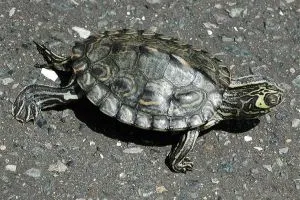
- Experience Level: NA
- Family: Emydidae
- Scientific Name: Graptemys barbouri
- Other Names: N/A
- Adult Size: 6 to 11 inches
- Lifespan: 15 to 20 years
- Average Price Range: NA
- Where to buy: Protected species
- Recommended Books: Turtles of the United States and Canada
Barbour’s Map turtles are the largest of the Map turtle subspecies. These turtles have gray oval-shaped shells with between two and four distinct spikes. They also have black and green skin with yellow stripes.
Barbour’s Map turtles are endemic to confined areas of Alabama, Florida, and Georgia. They prefer fast-moving waters. In Florida, this species is found in parts of the Apalachicola River as well as parts of Jackson County such as Dry Creek and Spring Creek.
These turtles are listed as Threatened in Florida, and it is illegal to own or sell Barbour’s Map turtles. Chemical contamination of their preferred waterways is one of the biggest threats facing this species because of their very specific range.
Barbour’s Map turtles are mostly carnivorous, feeding on amphibians, insects, and mollusks.
11. False Map Turtle
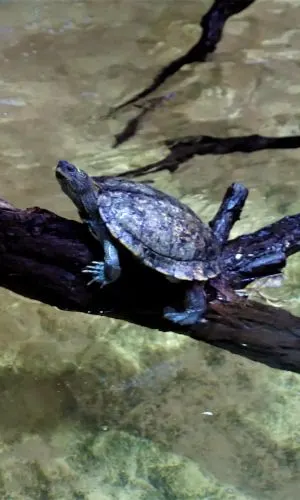
- Experience Level: Beginner
- Family: Emydidae
- Scientific Name: Graptemys pseudogeographica pseudogeographica
- Other Names: Sawback turtle
- Adult Size: 3.5 to 10.5 inches
- Lifespan: 30 to 50 years
- Average Price Range: $6 to $40
- Where To Buy: turtlesource.com
False Map turtles are a popular pet species but are often confused with other types of Map turtles. They have brown or black shells with contour-like yellow markings. Most adults have a pronounced keel on their backs, hence their nickname of Sawback turtle.
When housing a False Map turtle, males will need a smaller tank than females. 50-gallons is a good size for a male, while females will be happiest in 75-gallon tanks. These turtles like fast-moving waters, so a powerful filter is necessary.
The tank should have a basking platform with a temperature of around 85°F to 90°F. The water temperature needs to be somewhere near 75°F, with an ambient air temperature of 80°F to 85°F. A UVB light fixture will also be required.
Provide some cover in the form of artificial or live plants and aquarium decorations. False Map turtles are omnivores, and a staple diet of commercial pellets, crickets, mollusks, and worms should be supplemented with dark leafy greens.
Mud Turtles
12. Eastern Mud Turtle
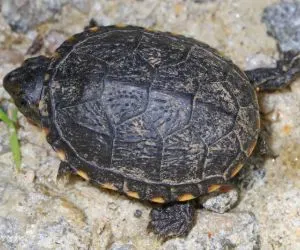
- Experience Level: Intermediate.
- Family: Kinosternidae
- Scientific Name: Kinosternon subrubrum
- Other Names: Common Mud turtle
- Adult Size: 3 to 4 inches
- Lifespan: 50 years
- Average Price Range: $65 to $120
Eastern Mud turtles are a small species of aquatic turtles that are known for their aggressive nature and sharply curved beaks. If an Eastern Mud turtle feels provoked, it won’t hesitate to bite you, so keep this in mind.
These little turtles are found in southern areas of Florida, preferring fixed-water areas such as lakes, ponds, rivers, and swamps.
Despite their small size, these turtles actually need a lot of swimming room. 40-gallons is the minimum size for an enclosure. Use a gravel substrate underneath the water, which allows the Eastern Mud turtle to burrow or walk along the bottom of the tank.
The water temperature for an Eastern Mud turtle needs to be kept at around 75°F, along with an air temperature ranging between 75°F and 80°F. A basking spot should also be provided and kept at around 90°F to 95°F.
Eastern Mud turtles also require exposure to UVB light, so having a UV bulb on a 12-hour day/night cycle is ideal. This helps your turtle to absorb much-needed nutrients and keeps it healthy.
Eastern Mud turtles are omnivores and should have a staple diet of insects, mollusks, and worms along with dark green leafy vegetables. Keep in mind that Mud turtles are messy eaters.
13. Florida Mud Turtle

- Experience Level: Intermediate
- Family: Kinosternidae
- Scientific Name: Kinosternon subrubrum steindachneri
- Other Names: Cow Dung Cooter
- Adult Size: 2.5 to 5 inches
- Lifespan: 20+ years
- Average Price Range: $100 to $300
- Where To Buy: theturtlesource.com
Until recently, the Florida Mud turtle was considered to be a subspecies of the Eastern Mud turtle. Now recognized as a distinct species, Florida Mud turtles are unsurprisingly endemic to the Florida Peninsula and are found in slow-moving freshwater areas such as rivers and swamps.
Florida Mud turtles have dark unmarked oval shells, with bright stripes extending back from their eyes. Adults do not have keels on their shells.
A 40-gallon tank is a good size for a Florida Mud turtle, and communal tanks are an option with this species. Like other Mud turtles, this species is a messy eater, so a strong filter system is essential. The water shouldn’t move too quickly though.
The ideal water temperature for this species is around 75°F, while the air temperature should be maintained between 75°F and 80°F. A basking spot should provide a UVB light as well as a heat lamp with a temperature of 85°F to 95°F.
Florida Mud turtles need an omnivorous diet consisting of crustaceans, insects, mollusks, and worms as well as commercial pellets and some dark leafy greens.
14. Striped Mud Turtle
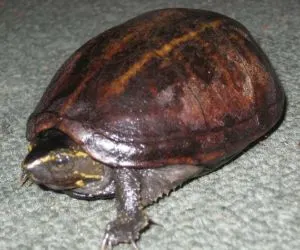
- Experience Level: Intermediate
- Family: Kinosternidae
- Scientific Name: Kinosternon baurii
- Other Names: Three-Striped Mud turtle
- Adult Size: 4 to 5 inches
- Lifespan: 15 to 20 years
- Average Price Range: $100 to $200
- Where to buy: Protected Species
Striped Mud Turtles are an Imperiled species in Florida, but are no longer considered to be in need of Federal Endangered Status. This small species of aquatic turtle is mostly found in Florida’s brackish and freshwater areas. Striped Mud turtles have dark brown oval-shaped shells with three yellowish vertical stripes.
A 20-gallon tank is the minimum size for a Striped Mud turtle, giving the turtle plenty of space for swimming. A good portion of the tank should be set up as a land area with a basking spot. Aquatic plants are good decorations for the tank.
Water temperature should be kept between 70°F and 75°F, with the basking spot ranging from 85°F to 90°F. A UVB light is also required to keep your turtle healthy. If you cannot maintain the correct water temperature naturally, use an underwater heater.
Because they are messy eaters, Striped Mud turtles need a strong three-stage filtration system. These tiny turtles are omnivores, and you should feed them insects, mealworms, and some leafy greens.
Musk Turtles
15. Common Musk Turtle

Common Musk Turtles (Sternotherus odoratus) near the water
- Experience Level: Beginner
- Family: Kinosternidae
- Scientific Name: Sternotherus odoratus
- Other Names: Stinkpot
- Adult Size: 2 to 4.5 inches
- Lifespan: 40 to 60 years
- Average Price Range: $50 to $100
Common Musk turtles are small nocturnal turtles found across much of the eastern United States, including Florida. They are most common in shallow, slow-moving waters with abundant aquatic vegetation and soft bottoms.
Common Musk turtles have dark brown or black unmarked shells. Their heads are also dark, with two yellowish stripes as well as fleshy barbels on their chins and necks.
Due to their small size, a 20-gallon tank is a good size. They need a strong filtration system as they can be quite messy eaters. Common Musk turtles do require a basking spot of around 90°F as well as a UVB light. The water temperature should be kept between 72°F and 78°F.
These turtles are omnivorous and should be fed a diet of insects, pieces of fish, mollusks, and worms along with commercial turtle pellets and some leafy greens for variety.
Common Musk turtles will release a potent odor from their musk glands when threatened, earning them the nickname of “Stinkpots”. They may also bite, so it’s advised that you only handle them when necessary.
16. Loggerhead Musk Turtle
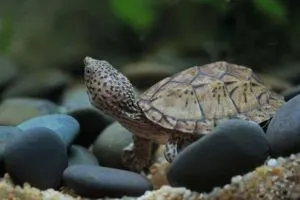
- Experience Level: Beginner
- Family: Kinosternidae
- Scientific Name: Sternotherus minor
- Adult Size: 3 to 4.5 inches
- Lifespan: 20 years
- Average Price Range: $100 to $250
- Where to buy: Reptilesncritters.com
Known for their disproportionately large head, Loggerhead Musk turtles are a distinctive sight in Florida’s aquatic habitats.
They are a distinctive species of Musk turtle found in the clear springs of northern Florida. These aquatic turtles are known for their large heads compared to their fellow Musk turtles. They have light brown keeled shells and grayish skin with black speckles.
Both the Loggerhead Musk turtle and its Stripe-necked Musk turtle subspecies (Sternotherus minor peltifer) can be found in Florida. They will have the same basic care requirements.
A minimum tank size of 30-gallons is required for housing a Loggerhead Musk turtle. They need a lot of room to swim. They will also need a basking spot of around 85°F to 90°F as well as a UVB light.
The water temperature for a Loggerhead Musk turtle needs to be kept at around 70°F, with an ambient air temperature of 75°F to 83°F. Aquatic plants and rocks are good decorations for the tank and will provide some cover.
Loggerhead Musk turtles prefer a carnivorous diet of insects, mollusks, worms, and commercial turtle pellets such as Mazuri or ReptoMin. Some leafy greens should be offered occasionally.
Painted Turtles
17. Southern Painted Turtle
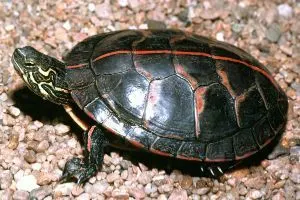
- Experience Level: Beginner
- Family: Emydidae
- Scientific Name: Chrysemys dorsalis
- Other Names: N/A
- Adult Size: Between 5 and 7 inches
- Lifespan: Between 20 and 50 years
- Average Price Range: Between $70 and $140
Southern Painted turtles are mainly found in slow-moving waters and floodplains. They are the smallest subspecies of the Painted turtle. They have smooth dark brown or black shells with orange or yellow bands running down the spine of the carapace.
These popular turtles will need similar care parameters to other Painted turtles. They will need a tank of around 100-gallons with a land area as well with a basking spot formed of large flat rocks. You’ll need to maintain good water quality, so a filtration system is essential.
Southern Painted turtles will also need a UVB light as part of their basking spot, which should be kept between 85°F and 95°F. The water temperature needs to be maintained between 75°F to 80°F, while ambient temperature should be kept at 80°F to 85°F.
Southern Painted turtles are omnivores and do well on a diet of commercial pellets, crickets, insects, and worms along with supplemental dark leafy greens or aquatic vegetation in their tanks.
Pond Sliders
18. Red-eared Slider

- Experience Level: Beginner
- Family: Emydidae
- Scientific Name: Trachemys scripta elegans
- Adult Size: 8 to 14 inches
- Lifespan: 20 years
- Average Price Range: $50 to $120
The Red-eared Slider is one of the most common species found in the pet trade. They are not native to Florida but have been introduced through the unsafe release of captive specimens. In many areas where they are non-native, Red-eared Sliders are considered to be invasive.
In Florida, it is illegal to acquire or import a Red-eared Slider as a pet unless you had one prior to July 2007. If you live in states where Red-eared Sliders are legal pets, you’ll find a brief overview of their care requirements below.
They are found in slow-moving warm waters and marshes. They are strong swimmers and spend the majority of their time underwater.
When keeping them as pets, a 40-gallon tank is the minimum size, but give them more space if you can. Change the water frequently and invest in a strong filter setup. For substrate, use gravel large enough that the Slider can’t swallow it.
Give them a swimming area with shallow water with a dock area to bask, which your Red-Eared Slider will do regularly. The ideal basking temperature is 95°F, while the water temperature should be kept at around 75°F.
UVB light is a must and should be kept on a 12-hour day/night cycle. Red-eared Sliders do not like frequent handling and may bite if they feel threatened. They need an omnivorous diet consisting of crickets, crustaceans, pellets, mollusks, and worms as well as leafy greens.
20. Yellow-bellied Slider

- Experience Level: Beginner
- Family: Emydidae
- Scientific Name: Trachemys scripta scripta
- Adult Size: 8 to 13 inches
- Lifespan: 30 to 40 years
- Average Price Range: $34 to $75
Yellow-bellied Sliders are one of the most common turtle species in Florida. They spend most of their time in the water and can be found across a wide range of habitats. These Sliders love to bask frequently as well.
As their name implies, these turtles have yellowish plastrons, as well as yellow markings across their skin. Yellow-bellied Sliders also have prominent yellow stripes behind their eyes. Their shells range from dark brown to olive.
This species need a huge amount of space, and should be housed either in an outdoor pond or in a 75 to 100-gallon tank. They can be messy, so a powerful filter setup is also necessary. You’ll need to provide a large basking spot for them to sun themselves with a UVB light and heat lamp.
Water temperature needs to be kept between 75°F and 80°F. If your climate doesn’t allow for this naturally, use a water heater during both day and night. The basking area should have a temperature of 80°F to 100°F.
Yellow-bellied Slider aren’t fussy eaters. These omnivores can feed on commercial pellets, crickets, insects, mollusks, and worms. Offer some dark leafy greens as well to give them a varied diet.
Snapping Turtles
21. Alligator Snapping Turtle

- Experience Level: Expert
- Family: Chelydridae
- Scientific Name: Macrochelys temmincki
- Other Names: Loggerhead Snapper
- Adult Size: 15 to 26 inches
- Weight: 220 pounds
- Lifespan: 20 to 70 years
- Average Price Range: NA
- Where to buy: Protected species
Alligator Snapping Turtles are the largest freshwater turtle species found in the United States, and one of the biggest species anywhere in the world. They are instantly recognizable thanks to their dinosaur-like appearance, with spiked shells, scaled tails, and powerful beaks.
In Florida, Alligator Snapping turtles can be found in sections of the Suwanee River area that runs westward through the Florida Panhandle. It is illegal to sell or keep this species as a pet in Florida. If you do live in a state where these turtles are legal captives, you should only think about keeping them if you are a seasoned turtle expert.
These massive monsters can be dangerous to inexperienced keepers. Their jaws are strong enough to cause significant damage if they bite you. You’ll ideally need an outdoor pond to house them, or something like a 200-gallon stock tank at a minimum as they need a lot of space.
Alligator Snapping turtles are largely carnivorous and should be fed small amphibians, fish, and mollusks or worms. They may occasionally eat aquatic vegetation or leafy greens. If you do live in a state where they can be kept as pets, visit our Alligator Snapping turtle care guide for more information.
22. Common Snapping Turtle

- Experience Level: Intermediate to Expert
- Family: Chelydridae
- Scientific Name: Chelydra serpentina
- Other Names: Common Snapper, Eastern Snapping turtle, Snapper
- Adult Size: Between 8 and 20 inches
- Lifespan: Between 30 and 50 years
- Average Price Range: Between $20 and $40
Common Snapping turtles are a large, freshwater species that are widespread across Florida. They usually prefer larger bodies of water. These turtles can be aggressive if they feel threatened and will bite. Only experienced turtle owners should even consider keeping a Common Snapping turtle.
Common Snapping turtles are easily identified by their distinctive hooked overbites. They usually have dark brown or green ridged shells. They also have strong claws and long tails bearing saw-toothed spines.
For housing a fully-grown specimen, you’ll need to use a Rubbermaid or stock tank up to 300-gallons, or house the Snapper in an outdoor pond. An external filter will be needed to help keep the tank clean.
If they live indoors, a basking spot will be required. But this can just be a UVB light positioned above the water surface, as Common Snappers will float at the surface while basking. Water temperature needs to be maintained at 80°F.
Common Snappers are omnivores but prefer a more meat-based diet of small amphibians, fish, insects, mollusks and worms. You can also offer them aquatic plants or dark leafy greens.
Softshell Turtles
23. Florida Softshell Turtle

- Experience Level: Expert
- Family: Trionychidae
- Scientific Name: Apalone ferox
- Adult Size: 6 to 12 inches (Males), 11 to 24 inches (Females)
- Lifespan: 50 years or more
- Average Price Range: $70 to $200
Florida Softshell turtles are the largest species of Softshell found anywhere in North America. They are the only type of Softshell turtle native to all regions of Florida, along with parts of Alabama, Georgia, and South Carolina.
They have dark brown to olive green carapaces that have a leathery texture and look like a pancake. Their plastrons are gray or white. They are fast whether moving on land or in the water.
Florida Softshells can be kept as pets. To house one, you’ll need at least a 200-gallon tank with some form of sandy substrate. This will give the turtle somewhere to bury itself.
The water temperature should be maintained between 70°F and 80°F. Ambient air temperature needs to be kept between 75°F and 85°F, with a basking spot of between 90°F and 100°F along with a UVB bulb.
Florida Softshells are carnivores and should be fed insects, mollusks, worms, and strips of fish. They don’t like to be handled and will often try to bite or scratch you with their sharp claws and teeth. This species is only recommended for more advanced turtle owners.
24. Gulf Coast Smooth Softshell

- Experience Level: Intermediate to Expert
- Family: Trionychidae
- Scientific Name: Apalone mutica calvata
- Other Names: N/A
- Adult Size: 4.5 to 10.5 inches (Males), 6.5 to 14 inches (Females)
- Lifespan: 25 years and over
- Average Price Range: Between $40 and $60
- Where To Buy: theturtlesource.com
Gulf Coast Smooth Softshells are a subspecies of the Smooth Softshell turtle found in the Florida Panhandle area. They are found in major river systems in this region and parts of Louisiana. They are fully aquatic, preferring fast-moving waters with muddy and sandy bottoms.
These Softshells have brown to tan shells that resemble leathery pancakes. Males are usually darker and smaller. Both genders have dark shell markings and the classic tapered Softshell snouts.
The minimum tank size for these turtles is around 75 to 100-gallons with a fast-moving filter system. You’ll need to use a fine muddy or sandy substrate and avoid gravel. Water temperature should be maintained between 70°F and 80°F using a water heater.
Gulf Coast Smooth Softshells will also need a basking spot with a UVB light. This should be in the form of a small land area or floating basking platform. These turtles don’t like to be handled and will bite and scratch if they feel threatened.
These turtles are mainly carnivores and should be fed crickets, insects, fish, mollusks, and worms. They can also eat commercial pellets.
25. Gulf Coast Spiny Softshell
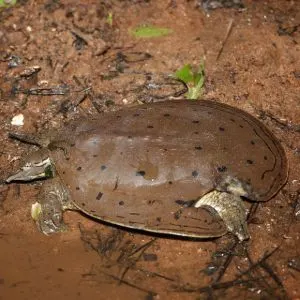
- Experience Level: Intermediate to Expert
- Family: Trionychidae
- Scientific Name: Apalone spinifera aspera
- Other Names: N/A
- Adult Size: 5 to 9.5 inches (Males), 7 to 19 inches (Females)
- Lifespan: 20 to 50 years
- Average Price Range: $70 to $280
- Recommended Books: Soft Shell Turtle Pet Owners Guide by Ben Team
Gulf Coast Spiny Softshell turtles are a subspecies of the Spiny Softshell turtle and are found in small pockets across Florida. They are more widespread in Alabama and parts of Georgia and South Carolina.
These turtles have leathery pancake-like shells with small spines. Gulf Coast Spiny Softshells have a series of black bars running around the rim of their shells, with ring-like markings on the upper shell. Carapace colors range from brown to tan.
Gulf Coast Spiny Softshells should be housed in a 75 to 100-gallon tank at a minimum. They need a fast current with a powerful filter as well as a finer substrate of mud or sand. They will not like gravel substrates. The water should range from 70°F to 80°F. A water heater is ideal.
Gulf Coast Spiny Softshells will also need exposure to UVB light in a basking spot such as a floating basking platform or a small terrestrial area. This species doesn’t tolerate handling well and will bite and scratch you.
Gulf Coast Spiny Softshells should be fed crickets, insects, fish, mollusks, and worms as part of a carnivorous diet. They can also eat commercial pellets.
Spotted Turtles
26. Spotted Turtle

- Experience Level: Beginner
- Family: Emydidae
- Scientific Name: Clemmys guttata
- Adult Size: 3.5 to 5 inches
- Lifespan: 25 to 35 years
- Average Price Range: $150 to $280
- Recommended Books: The Spotted Turtle: North America’s Best
The Spotted turtle is a small semi-aquatic species that favors bogs, swamps, and wetland habitats. Their smooth shells are black, covered with their eponymous bright yellow dots.
It is possible to keep this beautiful species as a pet. You’ll need a 20-gallon tank at minimum, preferable as a longer style of tank. This should be set up with both land and shallow water areas with logs and plants for cover. The water shouldn’t be deeper than the turtle’s head.
Water temperature should be maintained between 75°F and 80°F, and the basking area should be kept between 90°F to 95°F and provide a UVB light. A good filtration system is needed as this species can be messy, particularly when eating.
Spotted turtles prefer a more carnivorous diet and should be fed crustaceans, insects, mollusks, and worms. For some variety, offer small amounts of aquatic vegetation or dark leafy greens.
We’ll now cover both the Gopher tortoise and the five species of Sea turtles that can be spotted across the coastlines of Florida. While none of these species can be kept as pets, it’s useful to know a bit about them in case you are lucky enough to see them in the wild.
Tortoises in Florida
27. Gopher Tortoise

- Family: Testudinidae
- Scientific Name: Gopherus polyphemus
- Other Names:
- Adult Size: 10 to 15 inches
- Weight: 10 to 20 pounds
- Lifespan: 40 to 60 years in the wild
- Conservation Status: Vulnerable
- Habitat: Burrows which they dig in grasslands
- Clutch Size: Up to 25 eggs
- Food: Herbivores – plants and fruits and berries
- Appearance: Large tortoises with dark brown to gray shells. Elephant-like hind-legs.
Gopher tortoises are listed as Threatened in Florida. This keystone species is a vital part of Florida’s native ecosystem as their extensive burrows provide shelter for over 350 other species of animal. Gopher tortoises don’t mind sharing their burrows during disasters such as wildfires.
These tortoises have been spotted all across Florida, but their population faces threats from habitat loss and being killed by cars.
Check out our Gopher Tortoise page for more information.
Sea Turtles In Florida
Florida’s beaches, especially in areas like Broward County and Vero Beach, are critical nesting grounds for endangered sea turtles. Environmental groups and organizations like the Sea Turtle Preservation Society work tirelessly to protect these areas. Notably, leatherback nests have been observed along the coasts, showcasing the long distances these majestic creatures travel.
28. Green Sea Turtle

- Family: Cheloniidae
- Scientific Name: Chelonia mydas
- Other Names:
- Adult Size: Between 3 and 4 feet
- Weight: Between 300 and 400 lbs
- Lifespan: Between 80 and 100 years
- Conservation Status: Endangered
- Habitat: Bays and shores along coastlines and open ocean waters, seen during summer months
- Clutch Size: Around 110 to 115 eggs, with 2 to 5 clutches per breeding season
- Food: Mostly herbivores, eating algae, sea grasses and seaweed
- Appearance: Smooth green to brown shells shaped like hearts, edged in yellow. Cream colored scaly skin with shades of green
Green turtles are one of the world’s largest turtle species, weighing an average of 350 pounds and growing up to 4 feet in length. These herbivores mainly eat algae and seagrasses.
Over a thousand Green Sea turtles nest on Florida beaches between June and September, and the Florida coastline contains the most extensive network of Green Sea turtle nests in the western Atlantic Ocean.
These beautiful but endangered turtles face several threats such as sea pollution and being trapped in fishing nets.
Reaching sexual maturity at about 25 years, Green Sea Turtles’ longevity contributes significantly to their vulnerable status.
Head to our Green Sea turtles page for more information.
29. Hawksbill Sea Turtle
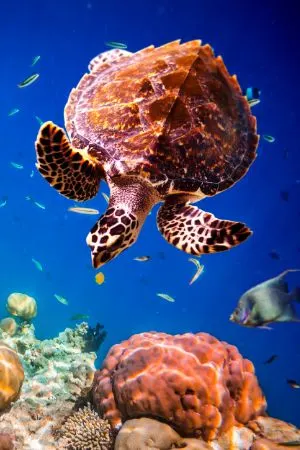
- Family: Cheloniidae
- Scientific Name: Eretmochelys imbricata
- Other Names:
- Adult Size: Between 30 and 35 inches
- Weight: Between 100 to 155 lbs
- Lifespan: Between 30 and 50 years
- Conservation Status: Critically Endangered
- Habitat: Shallow coastal areas of rocky or tropical waters, reefs and estuaries
- Clutch Size: Between 140 to 200 eggs, about 4 clutches per breeding season
- Food: Omnivores, mainly consuming crustaceans, mollusks, and algae
- Appearance: Prominent, beak-shaped mouths (like a hawk), oval shells in shades of amber with unique markings. Flippers also have claws at their “elbows”
Hawksbill Sea turtles are critically endangered, with only 8,000 nesting females found across the globe. In Florida, Hawksbill Sea turtles are mainly found on reefs in the Florida Keys as well as areas of the southeastern Atlantic coast. They nest in Florida from June to August.
Hawksbill Sea turtles are confronted with threats such as water pollution as well as being trapped in fishing nets or lines.
Their preference for coral reefs as feeding grounds makes Hawksbill Sea Turtles essential for the health of these marine ecosystems.
For more information, check out our Hawksbill Sea turtle page.
30. Kemp’s Ridley Sea Turtle

- Family: Cheloniidae
- Scientific Name: Lepidochelys kempii
- Other Names:
- Adult Size: Around 25 inches
- Weight: Between 75 and 100 lbs
- Lifespan: Around 30 years
- Conservation Status: Critically Endangered
- Habitat: Sandy or muddy coastlines with shallow waters
- Clutch Size: Between 100 and 110 eggs, 2 to 3 clutches per breeding season
- Food: Crustaceans, shellfish
- Appearance: Slightly hooked beaks, triangle-shaped heads. Green to gray round shells. Muted cream or yellow plastrons and undersides.
Kemp’s Ridley Sea turtles are the most endangered species of Sea turtle in the world. They can be spotted off the southwestern shores of Florida and nest from April to July. They can travel hundreds of miles to migrate to their preferred nesting sites.
Visit our Kemps Ridley sea turtle page for more information.
31. Leatherback Turtle

- Family: Dermochelyidea
- Scientific Name: Dermochelys coriacea
- Other Names:
- Adult Size: Between 6 and 7 feet
- Weight: Between 550 and 1500 lbs
- Lifespan: Around 30 years
- Conservation Status: Vulnerable
- Habitat: Warm waters, mainly shallow, calm bays or lagoons. Nests common on sandy beaches.
- Clutch Size: Between 100 and 110 eggs
- Food: Jellyfish is the staple of their diet, but they will also eat other sea creatures
- Appearance: Their large carapaces are soft, unique among sea turtles, with prominent ridges all the way down. Colors vary between black and a dark gray.
Leatherback Sea turtles are the largest turtle species on the planet, weighing up to 1500 lbs. These immense animals prefer the deepest and coldest waters of any Sea turtle and have the longest migration route.
Leatherback turtles nest exclusively on the eastern coast of Florida when nesting in America, with half of these nests found in Palm Beach. They are the only Sea turtle species that doesn’t have a hard outer shell.
For more information, see our Leatherback sea turtle page.
32. Loggerhead Sea Turtle
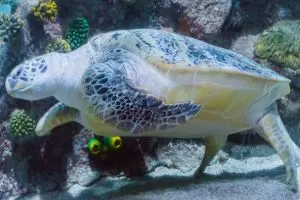
- Family: Cheloniidae
- Scientific Name: Caretta caretta
- Other Names:
- Adult Size: Between 30 and 45 inches
- Weight: Approximately 155 pounds
- Lifespan: Between 70 and 80 years
- Conservation Status: Endangered
- Habitat: Coastal regions, mainly shallow bays. Prefer sub-tropical waters. Sandy ocean beaches for nesting
- Clutch Size: Between 100 and 125 eggs, 4 to 5 clutches per breeding season
- Food: Carnivorous, mainly eating shellfish, mollusks, and crustaceans
- Appearance: Largest hard-shelled turtles with a reddish-brown carapace and large heads. Undersides are cream to yellowish. Long powerful flippers
Loggerhead Sea turtles are the most common Sea turtle species observed in Florida. They can be seen nesting along the Florida coast between April and September. These turtles swim thousands of miles to reach these prime nesting sites.
But the Loggerhead Sea turtle population is sadly decreasing due to being accidentally captured in fishing nets or traps.
Check out our Loggerhead sea turtle page for more information.
Conservation Efforts in Florida
Conservation efforts in Florida play a pivotal role in the survival of turtles. Organizations like the Sea Turtle Conservancy focus on protecting Florida’s coastlines, vital for the nesting of loggerhead and other sea turtles. They address threats like habitat loss and the impact of human activities. Nighttime sea turtle walks, often organized in counties like Brevard and Broward, are educational tools that raise awareness and support conservation.
Which Sea Turtles live in the Florida Keys?
The Florida Keys, a critical habitat for sea turtles, including the loggerhead, Kemp’s, Hawksbill, Green, and leatherback species, provide ideal conditions for nesting and feeding. Here, environmental groups actively engage in conservation efforts to protect these endangered species.
When female Sea turtles lay their eggs, the temperature of the sand can actually influence the sex of the hatchlings. Higher temperatures result in female hatchlings. When the baby turtles emerge, they must often cross large swathes of shoreline to reach the water, and many sadly die in the attempt.
Conclusion
Well there we go! In this extensive list we’ve covered the 32 species of turtles found in Florida. 26 of these species are freshwater turtles such as Box turtles, Snapping turtles, Softshells, and Mud and Musk turtles.
With each species, we’ve provided some basic care information to help you decide which one to choose as your next pet. Keep in mind that some species such as the Alligator Snapping turtle, Barbour’s Map turtle, Red-eared Slider, and Suwanee Cooter cannot be kept legally as pets.
We’ve also covered some endangered species that cannot be kept as pets, such as the Gopher tortoise and the five types of Florida Sea turtles. For these species, we’ve provided some basic information for you to refer to in case you’re fortunate enough to spot one of these rare animals in the wild.
It should be noted that the impact of climate change on Florida’s turtles, including shifts in habitat and nesting patterns, is a growing concern among conservationists.
In conclusion, the diverse turtle species in Florida, from the invasive species in Fort Lauderdale to the turtles on the endangered species list, reflect the state’s rich biodiversity. Proper understanding and good care of these species, particularly the female turtles that visit Florida’s beaches, are crucial for their conservation.
Have you seen a turtle that isn’t on this list in the wild in Florida? Let us know in the comments below.
Other nearby states
- Turtles in Alabama
- Turtles in Georgia
- Tortoises in Georgia
- Turtles in Louisianna
- Turtles in Mississippi
